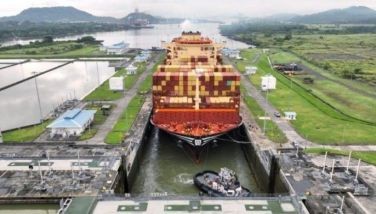Anti-mining advocates' side

Gina Lopez, the untiring managing director of ABS-CBN Foundation Inc. and stalwart champion of environment causes including No to Mining in Palawan movement and the Save Palawan movement, left with me a fair amount of reading materials on why mining must be banned in Palawan.
She was reacting to this column’s comments citing the overall economic benefits that mining could bring and in particular on our call to environmental activists to devote more of their resources and efforts to fighting the real threats to Palawan’s rich natural heritage and that collecting 10 million signatures supporting a total mining ban seems to be an over-reaction.
To give equal space to Gina Lopez and the No to Mining in Palawan organization’s position, and in the interest of transparency in this highly divisive issue, we are reprinting parts of the materials she handed me which is in response to the statements made by one of the mining companies operating at Palawan. Please read on.
“Gerard Brimo, president and CEO of Nickel Asia Corp., which is a member of the Chamber of Mines of the Philippines, defended big mining investments in Palawan and blamed the Save Palawan Movement for ‘misinformation’ and misleading the public. We would like to address his points one by one:
“1. Mr. Brimo says, ‘We don’t rape the land. We mine it, as others do all over the world, and after mining, we rehabilitate … the mining we do is no different from the mining done in other parts of the world. But it’s very much attacked in the Philippines.’
Small island ecosystems
“There is a big difference. The mining he is referring to is in countries like Australia, Africa, Canada, and China – which are huge continents with large tracts of land. The Philippines is an archipelago made up of small island ecosystems that are more vulnerable to landscape-wide changes and susceptible to extinction.
“Also, let’s be clear. Mining companies do not simply ‘mine the land.’ They bulldoze forests to make roads and their processing plants. They divert rivers, streams and other water sources that should have been for residential or irrigation use. They disturb the ecosystem…they displace people and biodiversity.
“2. Mr. Brimo also blamed small-scale – if not illegal mining – saying it had a greater adverse impact on Palawan’s natural resources.
“In truth, many small-scale mining companies are ‘offspring’ of mother companies that are members of the Chamber of Mines, the supposedly ‘responsible’ umbrella organization of the mining industry.
Small-scale mining firms
“In Palawan, some of the small-scale mining companies were organized by foreign firms which planned to conduct large-scale mining operations. One example is Mighty Beaut Minerals Inc. or MBMI of Canada, which secured a Financial Technical Assistance Agreement (FTAA) from the national government last year (although there has since been news that Malacañang has cancelled this FTAA).
“Another large mining company, the Platinum Group Metals Corporation (PGMC), also a member of the Chamber of Mines, also ran small-scale mining operations in Palawan.
“Palawan NGOs and communities have long taken issue with large-scale mining companies that have masqueraded themselves as small-scale mining entities to enable them to do mining while their Mineral Processing Sharing Agreements are being processed at the DENR.
“3. He says ‘One can’t make the case that Palawan is 100 percent biodiverse. That is not true. Biodiversity is in areas in northern Palawan.’
Biodiversity surveys
“We would love to see the biodiversity surveys that Mr. Brimo uses as basis for making outlandish claims like these. In reality, key biodiversity areas such as the Mt. Mantalingahan Protected Landscape (a protected area) and the Victoria-Anepahan Range, located in southern and central Palawan, respectively, and where there are current and planned large scale mining operations, have ultramafic forest, a rare forest type characterized by a high level of metallic compounds in the soil.
“In contrast, similar ultramafic forests in the island ecosystem of Sabah, such as in Mt. Kinabalu, Mt. Tawai and Mt. Silam are protected forests and not subjected to mining.
“4. In response to the argument that mining could affect food security, Brimo said areas mined were found to be ‘not fit for intensive agriculture’ as highly mineralized soil would only have grasses and ‘stunted shrubs.’
“This is not true. Mr. Brimo might be referring to the actual impact area of the mined out area. What he fails to see is that the run-off and other portions of the mining operations – tailings dam, processing plants, employees’ barracks, ports, roads – all these disturb the fragile ecosystem of the mining area.
“5. Mr. Brimo also makes a big deal about how mining firms reforest in mined-out areas, leaving mined-out areas with vegetation ‘better than the environment when we found it.’
“Tree-planting does not necessarily bring back biodiversity. Again, we would like to see Mr. Brimo’s before and after surveys of the biodiversity status in the areas they operate in.
Using old data
“6. He also claims that the Save Palawan Movement uses old data and photos of bad mining practices in the past to mislead the public.
“This is because there is no new data to prove otherwise. Twenty years after mining was stopped in Samar, the forest has not been revived. The Mining Act of 1995, meant to regulate the practices of large-scale mining, has not been able to prevent the Marcopper mining disaster in Marinduque in 1996, nor the cyanide spill resulting from Lafayette Mining in Rapu Rapu in 2002. The effects of these ‘old’ disasters are still evident today.
“They can try painting us as radical environmentalists. But we have truth on our side. The future of Palawan lies with agriculture, eco-tourism and its people. Not with the short-sighted greed and long-term destruction that mining will bring.”
Regional collegiate champions
Join for free the ongoing survey to identify the top regional collegiate basketball teams that are competing for seats in the Sweet 16 Finals of the PCCL (Champions League) 2011 National Collegiate Championship games.
Visit www.CollegiateChampionsLeague.net and submit your choices. Surprise gifts await those who will pick correctly the top teams.
Facebook and Twitter
We are actively using two social networking websites to reach out more often and even interact with and engage our readers, friends and colleagues in the various areas of interest that I tackle in my column. Please like us at www.facebook.com and follow us at www.twitter.com/ReyGamboa.
Should you wish to share any insights, write me at Link Edge, 25th Floor, 139 Corporate Center, Valero Street, Salcedo Village, 1227 Makati City. Or e-mail me at [email protected]. For a compilation of previous articles, visit www.BizlinksPhilippines.net.
- Latest
- Trending































